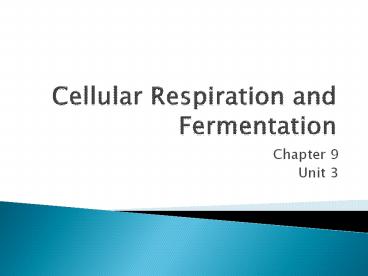Cellular Respiration and Fermentation PowerPoint PPT Presentation
Title: Cellular Respiration and Fermentation
1
Cellular Respiration and Fermentation
- Chapter 9
- Unit 3
2
Catabolic Pathways
- Fermentation
- Partial breakdown of sugars
- anaerobic
- Cell Respiration
- Most prevalent and efficient
- Complete breakdown of sugars
- aerobic
3
Redox Reactions Oxidation and Reduction
- Transfer of e- from one reactant to another
- Oxidation loss of electrons
- Reduction addition of electrons to another
substance - Reducing agent electron donor (C6H12O6)
- Glucose reduces oxygen which accepts the e-
- Oxidizing agent electron acceptor (6O2)
- Oxidizes glucose by accepting the e-
C6H12O6 6O2 ? 6H2O 6CO2
4
Energy Harvest via NAD
- Energy is released as electrons fall from
organic molecules to O2 - Broken down into steps
- Coenzyme NAD electron acceptor
- NAD picks up 2e- and 2H ? NADH (stores E)
- NADH carries electrons to the electron transport
chain (ETC) - ETC transfers e- to O2 to make H2O releases
energy
5
Substrate-Level Phosphorylation
- Phosphorylation enzyme transfers a phosphate
from a substrate to ADPother compounds - Mode of ATP synthesis
- ADP Pi ? ATP
6
Stages of Cellular Respiration
- Glycolysis
- Pyruvate oxidation and krebs
- Oxidative Phosphorylation ETC and chemiosmosis
7
Glycolysis
- sugar splitting
- Believed to be ancient (early prokaryotes)
- Occurs in cytosol
- Partially oxidizes glucose (6C) to 2 pyruvates
(3C) - Net gain 2 ATP 2NADH
- Also makes 2H2O
- Anaerobic
8
Occurs in two Phases
- Energy-investment phase uses two molecules of
ATP (5 steps) - Energy yielding phase produces four ATP
molecules and reduces two molecules of NAD to
NADH - The junction between Glycolysis and the Krebs
cycle is the oxidation of pyruvate to acetyl CoA. - two acetyl fragments are produced
9
(No Transcript)
10
Mitochondrion Structure
Citric Acid Cycle (matrix)
ETC (inner membrane)
11
Oxidation of Pyruvate
- Eukaryote-gt mitochondria
- Prokaryotes-gt cytosol
- Pyruvate is converted to coenzyme A (acetyl CoA)
12
Krebs Cycle (Citric acid cycle)
- Occurs in the mitochondrial matrix
- aerobic
- Completes glucose oxidation by breaking down
acetyl CoA into 3 molecules of carbon dioxide - Net gain 2 ATP, 6 NADH, 2 FADH2
13
(No Transcript)
14
Krebs cycle Evolution
- Evolved later than glycolysis
- bacteria ?3.5 billion years ago (glycolysis)
- free O2 ?2.7 billion years ago (photosynthesis)
- eukaryotes ?1.5 billion years ago (aerobic
respiration organelles ? mitochondria)
Hans Krebs 1900-1981
15
The Electron Transport Chain
- electron-carrier molecules built into the inner
mitochondrial membrane - Does not make ATP directly
- Eases the fall of e- from food to oxygen
- Oxygen final electron acceptor
16
Sequence of electron transfers along the electron
transport chain
17
Chemiosmosis
- ATP production
- This is accomplished by creating a proton
gradient - ATP synthase
- Cristae
18
How chemiosmosis works
- the electron transport chain creates the proton
gradient by pumping H from the mitochondrial
matrix - the membranes phospholipid bilayer is
impermeable to Hs and prevents back flow - As protons diffuse through the ATP synthase
complex phosphorylation of ADP occurs
19
Anaerobic Respiration
- Prokaryotes who live in environments w/o Oxygen
- Generate ATP using other electron acceptors
besides O2 - EX sulfur reducing bacteria use sulfate ions at
the end of their ETC - Hydrogen sulfide is produced
- Rotten egg odor in salt marshes or mud flats
20
Types of Fermentation
- Extension of glycolysis that allows continuous
generation of ATP - Types
- Alcoholic Fermentataion
- Pyruvate is converted to ethanol
- CO2 is released as it is converted to
acetaldehyde - Acetaldehyde is reduced by NADH to ethanol
- Regenerates NAD needed for glycolysis
21
- Lactic Acid Fermentation
- Pyruvate is reduced by NADH to form lactate as an
end product - Lactate that accumulates in muscle cells was
thought to cause muscle fatigue and pain, but now
it is suggested that pain comes from increased
levels of K - Lactate appears to enhance muscle performance
- Lactate is carried by the blood to the liver
where it is converted back to pyruvate.
22
Anaerobes
- Obligate Anaerobes carry out fermentation or
anaerobic respiration - Cannot survive in presence of Oxygen
- EX vertebrate brain cells cannot carry out
fermentation - Facultative Anaerobes use either fermentation or
respiration - Consumes more sugar when fermenting than
respiring to make same amt. of ATP - EX yeast, bacteria, muscle cells
23
Glycolysis
O2 present
Without O2
- Fermentation
- Respiration
- Keep glycolysis going by regenerating NAD
- Occurs in cytosol
- No oxygen needed
- Creates ethanol CO2 or lactate
- 2 ATP (from glycolysis)
- Release E from breakdown of food with O2
- Occurs in mitochondria
- O2 required (final electron acceptor)
- Produces CO2, H2O and up to 32 ATP

